
Prostanthera incisa, commonly known as cut-leaf mint-bush or native thyme, is a species of flowering plant in the family Lamiaceae and is endemic to south-eastern continental Australia. It is an erect, strongly aromatic, openly branched shrub with hairy, densely glandular branches, egg-shaped to oblong leaves, and pale mauve to mauve flowers.

Prostanthera phylicifolia, commonly known as spiked mint-bush, is a species of plant in the family Lamiaceae. It is an erect shrub with four-ridged branches, narrow egg-shaped to oval leaves and white or pale lilac-coloured flowers with purple and yellow spots.

Prostanthera cryptandroides is a species of flowering plant in the family Lamiaceae and is endemic to eastern Australia. It is a low, spreading shrub with narrow egg-shaped leaves and lilac to mauve flowers arranged singly in leaf axils.

Prostanthera stenophylla is a species of flowering plant in the family Lamiaceae and is endemic to Wollemi National Park in New South Wales. It is an erect, slender, aromatic shrub with hairy, oblong leaves and small groups of pale bluish mauve to violet flowers.
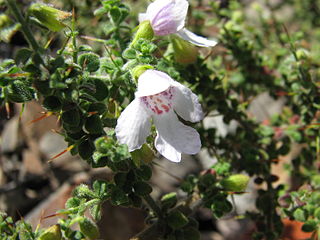
Prostanthera arapilensis is a flowering plant in the family Lamiaceae and is endemic to a small area of Victoria, Australia. It is an erect shrub with hairy branches, broadly egg-shaped to more or less round leaves and pale mauve or white flowers with orange-brown spots or streaks inside the petal tube.

Prostanthera decussata, commonly known as dense mintbush, species of flowering plant that is endemic south-eastern Australia. It is a dense, compact, strongly aromatic shrub with egg-shaped leaves and mauve to violet flowers with yellow streaks, arranged in leaf axils near the ends of branchlets.

Prostanthera rhombea, commonly known as sparkling mint-bush, is a plant in the family Lamiaceae and is endemic to disjunct areas of south-eastern Australia. It is an openly-branched shrub with strongly aromatic branches, circular to heart-shaped leaves and mauve or bluish flowers.

Prostanthera denticulata, commonly known as rough mint-bush, is a species of flowering plant in the family Lamiaceae and is endemic to coastal New South Wales. It is a straggling to almost prostrate, aromatic shrub with narrow egg-shaped leaves and purple to mauve flowers arranged in leaf axils or on the ends of branchlets.

Prostanthera saxicola is a species of flowering plant in the family Lamiaceae and is endemic to eastern Australia. It is a shrub with linear to elliptic leaves and white to mauve flowers arranged in leaf axils.
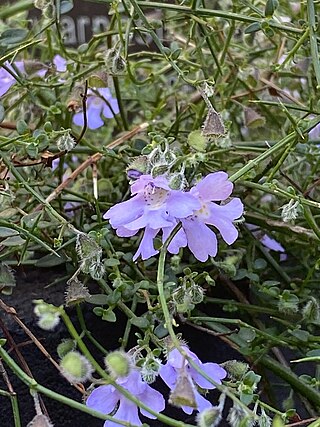
Prostanthera spinosa, commonly known as spiny mintbush, is a shrub that is endemic to south-eastern Australia. It has mauve to white flowers, spiny stems and aromatic foliage.
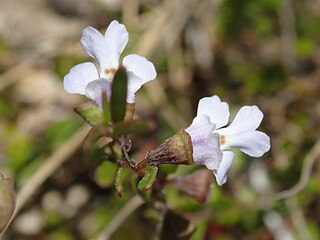
Prostanthera junonis, commonly known as Somersby mintbush, is a species of flowering plant in the family Lamiaceae and is endemic to the Central Coast of New South Wales. It is a low, straggling shrub with hairy, egg-shaped leaves and purple to mauve flowers.
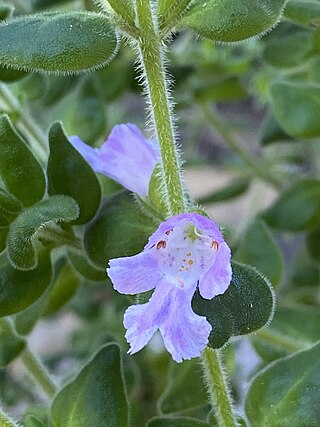
Prostanthera densa, commonly known as villous mint-bush, is a species of flowering plant in the family Lamiaceae and is endemic to near-coastal areas of New South Wales. It is an erect, often compact shrub with aromatic branches, egg-shaped leaves, and mauve flowers with orange markings inside.
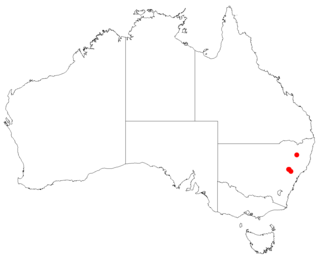
Prostanthera discolor is a species of flowering plant in the family Lamiaceae and is endemic to a small area of New South Wales. It is an open, erect, strongly aromatic shrub with lance-shaped to oblong leaves, and deep mauve to purple flowers with darker spots inside.
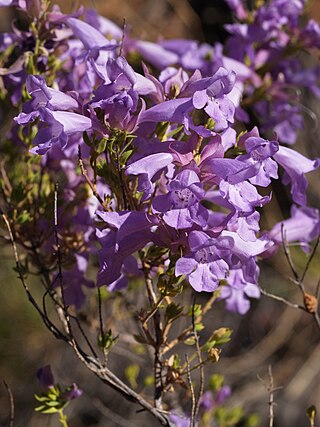
Prostanthera ferricola is a species of flowering plant in the family Lamiaceae and is endemic to central Western Australia. It is an erect, openly branched shrub with aromatic, egg-shaped leaves and mauve-purple flowers arranged in four to twelve leaf axils near the end of branchlets.
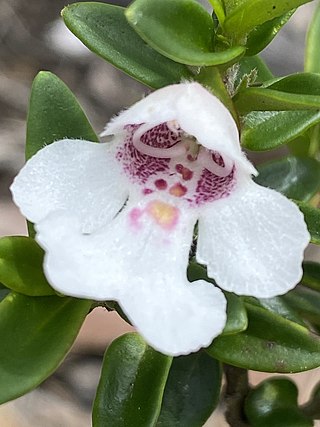
Prostanthera gilesii is a species of flowering plant in the family Lamiaceae and is endemic to the Mount Canobolas area of New South Wales. It is a small, compact, spreading shrub with aromatic, narrow egg-shaped to elliptical leaves, and white to yellowish white flowers with purple to dark mauve markings inside the petal tube and pale orange markings on the petal lobes.

Prostanthera lanceolata is a species of flowering plant in the family Lamiaceae and is endemic to near-coastal area of eastern Australia. It is an erect, aromatic shrub that has stems that are square in cross-section, glandular, egg-shaped leaves and mauve or deep bluish-purple flowers.
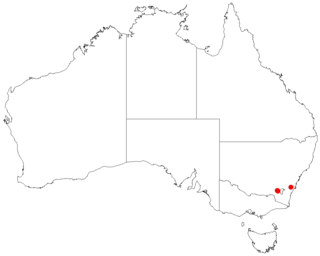
Prostanthera makinsonii is a species of flowering plant in the family Lamiaceae and is endemic to a restricted area of New South Wales. It is a spreading shrub with strongly aromatic, egg-shaped leaves and mostly glabrous purple flowers arranged in bunches of eight to twelve in upper leaf axils.

Prostanthera oleoides is a species of flowering plant that is endemic to central Queensland. It is an open, erect shrub with four-sided branchlets, narrow elliptic, oblong or egg-shaped leaves with the narrower end towards the base, and mauve flowers with purple to dark mauve markings.
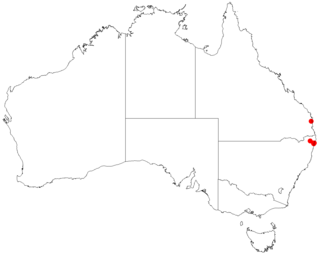
Prostanthera palustris, commonly known as swamp mint-bush, is a species of flowering plant in the family Lamiaceae and is endemic to a restricted area of New South Wales. It is a low, spreading, weak shrub with spatula-shaped leaves and pale mauve and white flowers with yellow spots in the petal tube.

Prostanthera violacea, commonly known as violet mint-bush, is a species of flowering plant in the family Lamiaceae and is endemic to south-eastern New South Wales. It is a slender, strongly aromatic shrub with densely hairy branches, more or less round leaves with the edges rolled under and mauve to bluish flowers often with white tips.




















